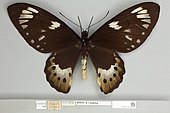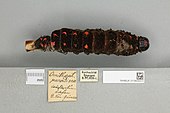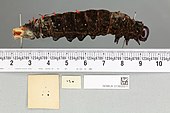|
Ornithoptera paradisea
Ornithoptera paradisea, the paradise birdwing, is a species of birdwing butterfly found in New Guinea. HistoryArnold Pagenstecher and Staudinger both described this butterfly, under different names and the first description by Staudinger was based on a manuscript sent to him by Pagenstecher who possessed specimens from the collection of D. Wolf von Schönberg in Naumburg who had acquired them from a colonist in the then German New Guinea. Pagenstecher's name is Schoenbergia schoenbergi and the year of publication also 1893. Robert Henry Fernando Rippon in his illustrated monograph Icones Ornithopterorum (1898 to 1906) attributes the name paradisea to both entomologists i.e. as Ornithoptera paradisea Pagenstecher and Staudinger. The holotype is held by Zoologische Staatssammlung München.[1] which also holds the type of Ornithoptera schoenbergi Pagenstecher. The type locality is the Finisterre Range, New Guinea. The specific epithet paradisea, is the Persian word for paradise.[citation needed] Description Ornithoptera paradisea is a large butterfly with a wingspan ranging from 140 mm to 190 mm. As they are sexually dimorphic, males and females differ in the size, shape and colour of the wings. Male: Males have black forewings. The costal edge is black and there are two large, yellow gold and green bands. The underside of the male forewing is green with black veins and at the apex there is a black area. The hindwings are tiny triangles, golden and with thin tails. The inner edge of the hindwing is black and there is usually a green stripe between the golden area and the inner edge. The outer edge of the hindwing is usually green. The underside is very similar to the upperside but the inner edge is green and hairy. The hindwings have tails of uncertain selective origin. The only other tailed Ornithoptera is Ornithoptera meridionalis. The abdomen is yellow, the head and thorax are black and green. Female: O. paradisea is strongly sexually dimorphic and the significantly larger female covers the upper range of the wingspan. The basic colour is dark-brown. Two groups of white spots dominate the forewing and on the hindwings there is a white area with a yellow outer edge. Between these there is a chain of black spots. The underside is very similar to the upperside, but the colours are stronger. The abdomen is yellow, the head and thorax are black and green. Biology and life cycle The habitat is lowland or montane primary forest. Adult males fly high around trees rarely descending to the ground. Females fly below the canopy searching for the food plant which is a species of Aristolochia with orange fruits. The male emits a pleasant scent from the fringe of white hairs along the anal vein of the hindwing. The egg is 4 mm. in diameter and light orange. Eggs are laid singly and are attached to the ventral surface of an Aristolochia leaf or a nearby object. The first instar larva is dark red wine colour. Instars 2-5 are velvet black and bear red tubercles with long black tips. The pupa is brown with a bright yellow and orange saddlemark. It has a waxy coating and two short, sharp spurs on abdominal segments 3–6. The eggs are parasitised by species of Chalcidoidea and the larvae are parasitised by Braconidae. Ants, lizards and birds eat the larvae and pupae and in monsoon the larvae suffer 30% mortality. The paradise birdwing is closely related to Ornithoptera meridionalis. Subspecies
The 2004 revision by Gilles Delisle accepts three subspecies Troides paradisea paradisea, Troides paradisea chrysanthemum and Troides paradisea arfakensis Joicey & Noakes, 1915 ConservationSupported by World Association of Zoos and Aquariums who claim that Papua New Guinea farmers achieve more income with breeding butterflies for life exhibits in zoos than with cultivation of coffee encourage support for the natural butterfly populations by cultivating food plants. Income is also made from sales to collectors. In his 1983 report to the Department of Primary Industries, Papua New Guinea, M.J. Parsons wrote that "Ironically it is now becoming an accepted fact that the very demand for Ornithoptera is one of the main assets which will ensure their future survival if they can be exploited in the correct way."[3] The paradise birdwing is listed on CITES appendix II, limiting the international exportation of the species to those who are granted a permit.[4] GallerySelection of museum specimens of Ornithoptera paradisea
References
Other sources
External linksWikimedia Commons has media related to Ornithoptera paradisea. Wikispecies has information related to Ornithoptera paradisea.
|
||||||||||||||||||||||||||||||||||||||











